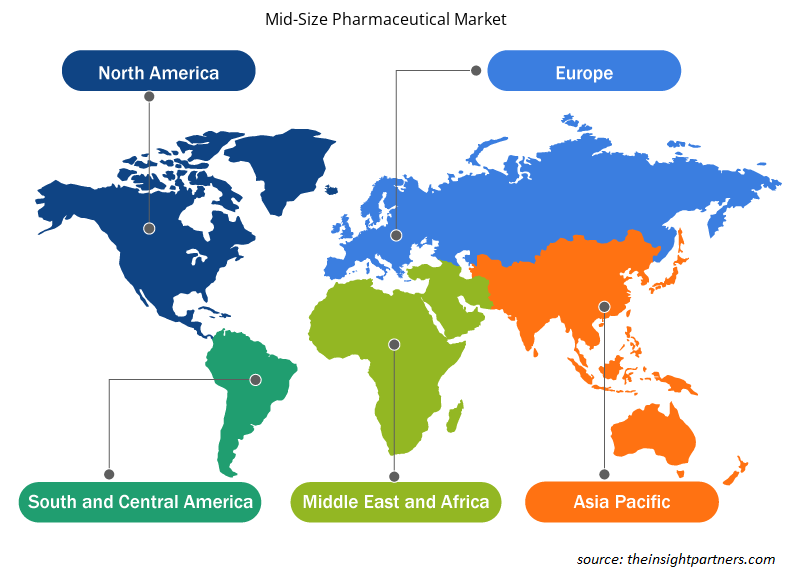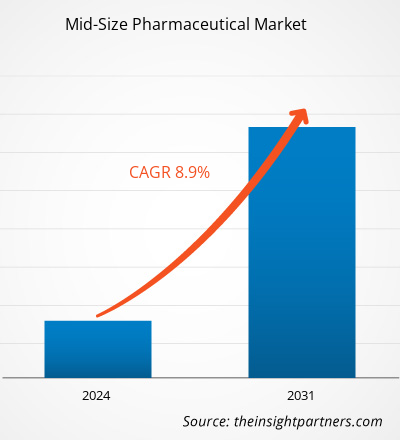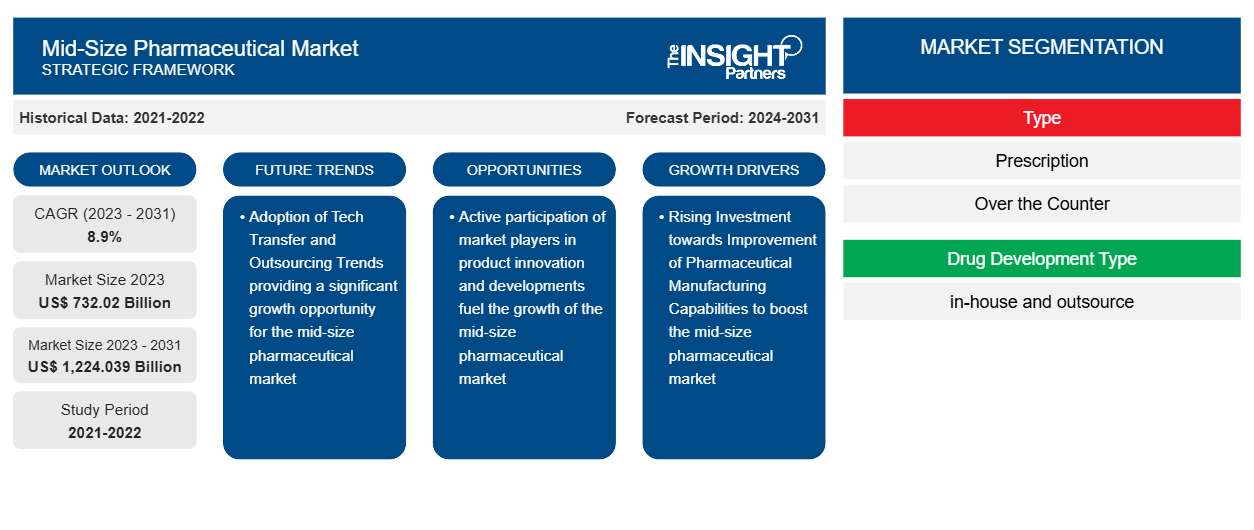Der Markt für mittelgroße Pharmaunternehmen soll von 732,02 Milliarden US-Dollar im Jahr 2023 auf 1.224,039 Milliarden US-Dollar im Jahr 2031 anwachsen. Für den Zeitraum 2023–2031 wird eine durchschnittliche jährliche Wachstumsrate (CAGR) von 8,9 % erwartet.Eine stärkere Konzentration auf Forschung und Entwicklung wird voraussichtlich ein wichtiger Trend auf dem Markt bleiben.
Analyse des mittelgroßen Pharmamarktes
Das Wachstum des Marktes wird durch wichtige treibende Faktoren wie die weltweit steigende Zahl geriatrischer Bevölkerungsgruppen und die zunehmende Verbreitung chronischer Erkrankungen bestimmt. Darüber hinaus hat die zunehmende Urbanisierung die staatlichen Ausgaben für den Gesundheitssektor erhöht. Darüber hinaus dürfte die steigende Zahl von Start-ups im Gesundheitswesen in den kommenden Jahren Chancen für den mittelgroßen Pharmamarkt bieten.
Übersicht über den Markt mittelgroßer Pharmaunternehmen
Die alternde Bevölkerung und Veränderungen im Sozialverhalten tragen zum stetigen Anstieg dieser weit verbreiteten und kostspieligen langfristigen Gesundheitsprobleme bei. Mit der zunehmenden Urbanisierung verlagern die Menschen ihre Aktivitäten immer mehr in die Bewegungsfreiheit. Dies führt zu einem Anstieg der Fettleibigkeitsraten und von Krankheiten wie Diabetes. Laut der Weltgesundheitsorganisation wird die Prävalenz chronischer Krankheiten bis 2026 voraussichtlich um 57 % zunehmen. Die Schwellenmärkte werden am härtesten betroffen sein, da das Bevölkerungswachstum in den Entwicklungsländern voraussichtlich am stärksten ausfallen wird. Die zunehmende Nachfrage nach Gesundheitssystemen aufgrund chronischer Krankheiten ist zu einem erheblichen Problem geworden.
Diabetes ist eines der größten globalen Gesundheitsprobleme des 21. Jahrhunderts. Jedes Jahr erkranken mehr und mehr Menschen an dieser Krankheit, die lebensverändernde Komplikationen verursacht. Laut der International Diabetes Federation (IDF) lag die Zahl der Menschen mit Diabetes in Nordamerika im Jahr 2019 bei etwa 46 Millionen und soll bis 2045 auf 62 Millionen ansteigen. Der Anstieg der Krankheitsprävalenz beträgt im prognostizierten Zeitraum etwa 35 %. Die Pandemien haben die Geschwindigkeit, mit der sich Infektionen weltweit ausbreiten, auf die Probe gestellt. Pandemien üben periodische und enorme Belastungen auf Gesundheitssysteme aus. Gesundheitseinrichtungen auf der ganzen Welt müssen darauf vorbereitet sein, Ausbrüche einzudämmen, wenn sie gemeinsam auftreten. Daher beflügelt die zunehmende Verbreitung chronischer Erkrankungen den mittelgroßen Pharmamarkt.
Passen Sie diesen Bericht Ihren Anforderungen an
Sie erhalten kostenlos individuelle Anpassungen an jedem Bericht, einschließlich Teilen dieses Berichts oder einer Analyse auf Länderebene, eines Excel-Datenpakets sowie tolle Angebote und Rabatte für Start-ups und Universitäten.
-
Holen Sie sich die wichtigsten Markttrends aus diesem Bericht.Dieses KOSTENLOSE Beispiel umfasst eine Datenanalyse von Markttrends bis hin zu Schätzungen und Prognosen.
Treiber und Chancen für den mittelgroßen Pharmamarkt
Steigerung der Produktzulassungen und -einführungen
Der mittelgroße Pharmamarkt ist durch die Präsenz verschiedener Marktteilnehmer gekennzeichnet. Um ihren Marktanteil zu erhöhen, verfolgen die Marktteilnehmer verschiedene Strategien wie Produkteinführungen, regionale Expansion und technologische Fortschritte. Mittelgroße Pharmaunternehmen sind stärker an kontinuierlicher Innovation und technologischen Fortschritten beteiligt, was zu einer höheren Akzeptanz unter den Branchenakteuren führt. Führende Akteure investieren in Forschung und Entwicklung, um fortschrittliche Technologien zu entwickeln und mehr Umsatz zu erzielen. So brachte Eisai Co., Ltd. im Mai 2022 MOVICOL HD auf den Markt, eine weiterentwickelte Formulierung des bestehenden MOVICOL LD zur Behandlung chronischer Verstopfung. EA Pharma und Eisai Co., Ltd. stellten im Rahmen einer Co-Promotion-Vereinbarung gemeinsam Informationen zur ordnungsgemäßen Verwendung von MOVICOL HD bereit. Darüber hinaus gab Sun Pharmaceutical Industries Ltd., einschließlich seiner Tochtergesellschaften und assoziierten Unternehmen, im Mai 2022 bekannt, dass es von der US-amerikanischen FDA die endgültige Genehmigung für seinen Abbreviated New Drug Application (ANDA) für generische Mesalamin-Retardkapseln, 500 mg, erhalten hat. Die Zulassung des Generikums basierte auf Pentasa Extended-Release-Kapseln, 500 mg als Referenzprodukt.
Steigende Zahl von Startups im Gesundheitswesen
Im letzten Jahrzehnt hat die Pharmaindustrie viele bahnbrechende Trends und Innovationen erlebt, die die für Patienten auf der ganzen Welt verfügbaren Medikamente rasch verbessern werden. In nur zehn Jahren haben der Einfluss künstlicher Intelligenz und Big Data auf die Diagnose und Behandlung von Krankheiten sowie eine Verlagerung hin zur Prävention lebensbedrohlicher Erkrankungen statt ihrer medikamentösen Behandlung zur Entwicklung des Gesundheitswesens geführt. Mit der Entwicklung neuer Technologien gründen neue Marktteilnehmer mehrere Gesundheits-Start-ups und beeinflussen so den mittelgroßen Pharmamarkt. Zum Beispiel: Alpha Zyme wurde 2018 von Christopher Benoit gegründet, einem Experten für Enzymentwicklung und -produktion. Im Oktober 2020 ging Alp Zyme eine Partnerschaft mit Qualio ein, um das Wachstum des Unternehmens zu fördern.
Segmentierungsanalyse des mittelgroßen Pharmamarktberichts
Wichtige Segmente, die zur Ableitung der Analyse des mittelgroßen Pharmamarkts beigetragen haben, sind Typ, Art der Arzneimittelentwicklung, Formulierungen und Therapieklasse.
- Der mittelgroße Pharmamarkt ist nach Typ in verschreibungspflichtige und rezeptfreie Arzneimittel unterteilt. Das rezeptfreie Segment hatte im Jahr 2023 den größten Marktanteil.
- Basierend auf der Art der Arzneimittelentwicklung ist der mittelgroße Pharmamarkt in Inhouse und Outsourcing segmentiert. Das Outsourcing-Segment hatte im Jahr 2023 den größten Marktanteil.
- Basierend auf den Formulierungen ist der mittelgroße Pharmamarkt in Tabletten und Kapseln, Injektionspräparate, Sprays und andere Formulierungen segmentiert. Das Segment Tabletten und Kapseln hatte im Jahr 2023 den größten Marktanteil.
- Basierend auf der Therapieklasse ist der mittelgroße Pharmamarkt nach Herz-Kreislauf-Erkrankungen, Schmerzbehandlung, Diabetes, Krebs und anderen Erkrankungen segmentiert. Das Diabetes-Segment hatte im Jahr 2023 den größten Marktanteil.
Marktanteilsanalyse für mittelgroße Pharmaunternehmen nach geografischer Lage
Der geografische Umfang des Berichts zum mittelgroßen Pharmamarkt ist hauptsächlich in fünf Regionen unterteilt: Nordamerika, Asien-Pazifik, Europa, Naher Osten und Afrika sowie Süd- und Mittelamerika.
Die USA sind der größte Markt für mittelgroße Pharmaunternehmen in Nordamerika. In Nordamerika halten die USA einen bedeutenden Anteil am Markt für mittelgroße Pharmaunternehmen. Das Wachstum des Marktes im Land wird hauptsächlich durch die zunehmende Alterung der Bevölkerung in den USA und die zunehmende Verbreitung chronischer Krankheiten vorangetrieben. Die zunehmende Alterung der Bevölkerung in den USA wird wahrscheinlich das Wachstum des Marktes für mittelgroße Pharmaunternehmen begünstigen. Laut dem US Census Bureau wird sich die Zahl der über 65-Jährigen in den USA voraussichtlich von 52 Millionen im Jahr 2018 auf rund 95 Millionen bis 2060 verdoppeln, und der Anteil der über 65-Jährigen wird im Zeitraum von 2018 bis 2060 von 16 % auf 23 % steigen.
Die meisten Erwachsenen (> 60 %) leiden an zwei oder mehr chronischen Erkrankungen. Nach Angaben der Centers for Disease Control and Prevention (CDC) litten im Jahr 2020 fast 6 von 10 Menschen in den USA an mindestens einer chronischen Krankheit und 4 von 10 Menschen hatten zwei oder mehr chronische Erkrankungen. Darüber hinaus sind chronische Erkrankungen wie Demenz, Herzkrankheiten, Typ-2-Diabetes, Arthritis und Krebs alle mit dem Altern verbunden. Dies sind wesentliche Ursachen für Krankheit, Behinderung, Sterblichkeit und steigende Gesundheitskosten in den USA.
Regionale Einblicke in den mittelgroßen Pharmamarkt
Die regionalen Trends und Faktoren, die den mittelgroßen Pharmamarkt während des Prognosezeitraums beeinflussen, wurden von den Analysten von Insight Partners ausführlich erläutert. In diesem Abschnitt werden auch die Segmente und Geografien des mittelgroßen Pharmamarkts in Nordamerika, Europa, im asiatisch-pazifischen Raum, im Nahen Osten und Afrika sowie in Süd- und Mittelamerika erörtert.

- Erhalten Sie regionale Daten für den mittelgroßen Pharmamarkt
Umfang des Berichts zum mittelgroßen Pharmamarkt
| Berichtsattribut | Details |
|---|---|
| Marktgröße im Jahr 2023 | 732,02 Milliarden US-Dollar |
| Marktgröße bis 2031 | 1.224,039 Milliarden US-Dollar |
| Globale CAGR (2023 - 2031) | 8,9 % |
| Historische Daten | 2021-2022 |
| Prognosezeitraum | 2024–2031 |
| Abgedeckte Segmente |
Nach Typ
|
| Abgedeckte Regionen und Länder |
Nordamerika
|
| Marktführer und wichtige Unternehmensprofile |
|
Dichte der Akteure im mittelgroßen Pharmamarkt: Die Auswirkungen auf die Geschäftsdynamik verstehen
Der Markt für mittelgroße Pharmaprodukte wächst rasant. Dies wird durch die steigende Nachfrage der Endverbraucher aufgrund von Faktoren wie sich entwickelnden Verbraucherpräferenzen, technologischen Fortschritten und einem größeren Bewusstsein für die Vorteile des Produkts vorangetrieben. Mit der steigenden Nachfrage erweitern Unternehmen ihr Angebot, entwickeln Innovationen, um die Bedürfnisse der Verbraucher zu erfüllen, und nutzen neue Trends, was das Marktwachstum weiter ankurbelt.
Die Marktteilnehmerdichte bezieht sich auf die Verteilung der Firmen oder Unternehmen, die in einem bestimmten Markt oder einer bestimmten Branche tätig sind. Sie gibt an, wie viele Wettbewerber (Marktteilnehmer) in einem bestimmten Marktraum im Verhältnis zu seiner Größe oder seinem gesamten Marktwert präsent sind.
Die wichtigsten Unternehmen, die auf dem mittelgroßen Pharmamarkt tätig sind, sind:
- DAIICHI SANKYO COMPANY LIMITED;
- Eisai Co., Ltd.;
- Regeneron Pharmaceuticals, Inc.;
- Bausch Health Companies Inc.;
- Sun Pharmaceutical Industries Ltd.;
- Alexion Pharmaceuticals, Inc.;
Haftungsausschluss : Die oben aufgeführten Unternehmen sind nicht in einer bestimmten Reihenfolge aufgeführt.

- Überblick über die wichtigsten Akteure im mittelgroßen Pharmamarkt
Nachrichten und aktuelle Entwicklungen im mittelgroßen Pharmamarkt
Der mittelgroße Pharmamarkt wird durch die Erhebung qualitativer und quantitativer Daten nach Primär- und Sekundärforschung bewertet, die wichtige Unternehmensveröffentlichungen, Verbandsdaten und Datenbanken umfasst. Nachfolgend sind einige der Entwicklungen im mittelgroßen Pharmamarkt aufgeführt:
- Regeneron Pharmaceuticals, Inc. und Checkmate Pharmaceuticals, Inc. haben eine endgültige Vereinbarung bekannt gegeben, wonach Regeneron Checkmate für 10,50 USD pro Checkmate-Stammaktie in einer Bartransaktion erwirbt. Der gesamte Aktienwert von Checkmate wird bei der geplanten Übernahme auf rund 250 Millionen USD geschätzt. (Quelle: Regeneron Pharmaceuticals, Inc., Unternehmenswebsite, April 2022)
Bericht zum Markt für mittelgroße Pharmaunternehmen: Abdeckung und Ergebnisse
Der Bericht „Marktgröße und Prognose für mittelgroße Pharmaunternehmen (2021–2031)“ bietet eine detaillierte Analyse des Marktes, die die folgenden Bereiche abdeckt:
- Größe und Prognose des mittelgroßen Pharmamarktes auf globaler, regionaler und Länderebene für alle im Rahmen des Projekts abgedeckten wichtigen Marktsegmente
- Trends im mittelgroßen Pharmamarkt sowie Marktdynamik wie Treiber, Hemmnisse und wichtige Chancen
- Detaillierte PEST/Porters Five Forces- und SWOT-Analyse
- Analyse des mittelgroßen Pharmamarkts, die wichtige Markttrends, globale und regionale Rahmenbedingungen, wichtige Akteure, Vorschriften und aktuelle Marktentwicklungen abdeckt.
- Branchenlandschaft und Wettbewerbsanalyse, einschließlich Marktkonzentration, Heatmap-Analyse, prominenten Akteuren und aktuellen Entwicklungen für den mittelgroßen Pharmamarkt
- Detaillierte Firmenprofile
- Historische Analyse (2 Jahre), Basisjahr, Prognose (7 Jahre) mit CAGR
- PEST- und SWOT-Analyse
- Marktgröße Wert/Volumen – Global, Regional, Land
- Branchen- und Wettbewerbslandschaft
- Excel-Datensatz
Aktuelle Berichte
Verwandte Berichte
Erfahrungsberichte
Grund zum Kauf
- Fundierte Entscheidungsfindung
- Marktdynamik verstehen
- Wettbewerbsanalyse
- Kundeneinblicke
- Marktprognosen
- Risikominimierung
- Strategische Planung
- Investitionsbegründung
- Identifizierung neuer Märkte
- Verbesserung von Marketingstrategien
- Steigerung der Betriebseffizienz
- Anpassung an regulatorische Trends























 Kostenlose Probe anfordern für - Mittelständischer Pharmamarkt
Kostenlose Probe anfordern für - Mittelständischer Pharmamarkt